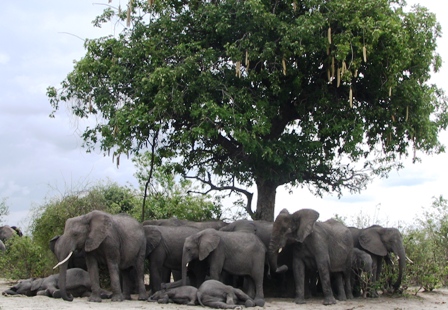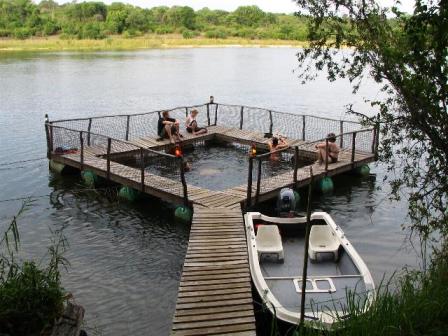
Click the photo of elephants above to see an album of photos. Close the window to return to this page.
Read previous South Africa to Namibia with Drifters or next Eastern South Africa
 The Caprivi Strip,
a strip of land nestled between Angola, Zambia, and
Botswana is the western entrance to the Okavango Delta.
We stayed one night at Ngepi Camp in the Caprivi Strip on
the Okavango River. We camped on the grass beside the
river but there were tree houses and bush huts to rent.
The campers shared whimsically designed flush toilets and
showers open to the elements. The throne room had a
suitable raised seat and the room with a view faced
flowers and bushes. The resort boasts the world's first
anti-crocodile and hippo fenced swimming enclosure in the
river. We were happy to swim in the enclosure as the
water was lovely but the current was very strong. We
didn't see any hippos or crocodiles, but hippos were
sighted earlier in the afternoon and they have been known
to come ashore in the evening to graze. The Caprivi Strip,
a strip of land nestled between Angola, Zambia, and
Botswana is the western entrance to the Okavango Delta.
We stayed one night at Ngepi Camp in the Caprivi Strip on
the Okavango River. We camped on the grass beside the
river but there were tree houses and bush huts to rent.
The campers shared whimsically designed flush toilets and
showers open to the elements. The throne room had a
suitable raised seat and the room with a view faced
flowers and bushes. The resort boasts the world's first
anti-crocodile and hippo fenced swimming enclosure in the
river. We were happy to swim in the enclosure as the
water was lovely but the current was very strong. We
didn't see any hippos or crocodiles, but hippos were
sighted earlier in the afternoon and they have been known
to come ashore in the evening to graze.We drove south to the Namibian-Botswana border and on to Drifters Camp near Maun, Botswana on the Okavango River. We relaxed for the afternoon in the pool overlooking the river but we missed the hippo-proof cage. There was great excitement in the early evening when it was discovered that a cobra had taken refuge one of the toilets. No one went near that toilet again until we were assured the snake had gone. Any open door is an invitation to wild creatures. This was the dry season in the Okavango Delta, the largest inland delta in the world. Waters from Angola feed the Okavango. The wet season doesn't start in Angola for another month or two and it takes several months for the waters to reach the Okavango. Our visit to the Delta entailed flying into the center of the Okavango Delta to an island in the middle of the permanent waterways. We all elected to take the longer more scenic flight over the Delta. We flew in two Cessnas at an altitude of 500 ft to the tiny Pom-pom airfield near Chief Island. We saw a herd of about 20 elephants, antelope and a few lone giraffe and rhino but it was interesting to see the extent of the Delta.
An open game viewing truck was waiting to take us across to the open water where we transferred to mekoros (plural). A mokoro (singular) is a log dugout canoe but ours were fiberglass as the traditional logs only last six months and there are not enough trees to make more. Each mokoro, propelled by a poler standing at the rear, had seats for two passengers and their luggage. We had a leisurely ride through the papyrus and pampas grass lined canals to small Baobab Island where Drifters maintains a permanent campsite. A 20 minute walk took us to the tents setup in a circle under a tree. Looking up into the tree we realized their was an immature Fishing Owl perched there waiting to go hunting after dark. Later in the afternoon, after the heat dissipated, Johan and Oscar, the head mokoro polers, took us on a walking tour of the island. There are lots of elephant in the area, as evidenced by the mounds of elephant dung. Their trail led right through our tent site and they did manage to trample a few of the tents in an overflow area, but didn't come near us. We did see several Lechwe antelope that are only found in the Delta. Oscar picked herbs from several of the bushes nearby and explained how they are used as traditional medicine. Johan picked a hole in one of the many tall termite hills so that we could see the worker termites rush out to repair the damage.
The next morning we reversed the journey out in the mekoros to trade places in a Cessna with another Drifters group who would be staying three nights in the Delta. We flew straight back to Maun this time and returned to the Drifters Camp on the Okavango with just enough time for lunch and a shower before heading off in the Green Machine again.
We were all fascinated by the colourful outfit worn by an African woman near Maun. She wore a dress with a full skirt and a headdress of the same patterned material, rolled into horn-like protrusions on the sides of the cap. I thought it must be a Sunday-best outfit but Johan said the women in that area wore similar outfits all the time. We travelled through the flat, desolate salt pans of Nxai and Madgadikgadi National Parks to Nata Lodge, at the edge of the Madgadikgadi Pan. Nata Lodge was more upscale than many of the resorts we stayed in. There were large cabins, a restaurant and a swimming pool fed by a waterfall. Even the camping area had some of the best toilet and shower areas. I would have loved to take home one of the round ceramic sinks with a circle of hippos around the edge.
We left Kasane just as a severe rainstorm started. We had experienced thunder and lightening overnight, a prelude to the rainy season, but the rains had bypassed us; that is until now. The winds and rain were so strong we had to crawl along the road to the Botswana border. We got a little wet running into the immigration office to get our passports stamped and it was still raining when we reached the Zimbabwe border, but that was the end of the storm. We had a bit of a surprise at the Zimbabwe border. Johan had told us that we would have to buy a Visa for 30US$, but new regulations had come in March 1 2006 charging British and Irish citizens 55US$ and Canadians 65US$! Sara Regina thought she had remembered a demonstration by British and Irish last February and Canadian issuing an anti-Zimbabwe statement as part of the demonstration. That was the only explanation we could think of for the increased fee.
We stayed at Drifters Lodge in Victoria Falls for two nights, enough time to see the famous falls and if we wished, to take part in the various adventure activities offered. Ray and I limited ourselves to a Falls visit and souvenir shopping while some of the others opted for river rafting and bungy jumping.
We found the Zimbabweans friendly and helpful although there are grave problems in the country. Zimbabwe is experiencing inflation worse than any of us can imagine. It has caused hardship for everybody. Petrol prices are over 9 US$ per litre, causing the cancellation of the already scarce public minibus system. The area businesses don't want to trade in Zimbabwean Dollars, they want Rand, Botswanan Pua, or the US Dollar, that they can trust. The official bank rate was 250 Zim$ for 1 US$, but the unofficial black market rate was 1,500 Zim$ for 1 US$. Several restaurants in Vic Falls were offering a 40% discount if you paid in US$. The Drifters Manager told us that he trades in US$ because the authorities require a bank certificate for all Zim$. If this is not produced, fines or jail sentences could be levied. He told us most people are buying goods with Zim$ rather than keeping a currency that might be worth much less tomorrow. Even the craft market sales people prefer to trade a curio for a T-shirt or other article of clothing rather than accept Zim$.
Ivory Lodge, on the border of Hwange National Park, is under new management and in the process of renovating several of their stilted cabins with views of their private water hole. We camped but as usual, had the use of their pleasant swimming pool and bar area. Kelly, who works at the lodge, took us on an afternoon game drive in Hwange. We stopped first to visit a new South African Painted Wild Dog conservation center. The local farmers who didn't appreciate their livestock being decimated by these extremely efficient hunters hunted the dogs almost to extinction. The center now takes in orphan pups from South Africa, trains and releases them into the wild. Later we saw five of the dogs come to drink at the Ivory Lodge waterhole.
Our last stop in Zimbabwe was to the camping area of the upscale Big Cave Camp near Matobo National Park. It started to rain soon after we arrived at our camp site so we quickly erected our tents and for the first time, rolled out a huge tarpaulin from the side of the Green Machine to use as a meal shelter. The rain stopped just before we left on our afternoon game drive to Matobo with our guides Dave and Norman. Matobo, named for the unusual rock formations throughout the park, was inhabited for over 40,000 years and is still considered a sacred place. Cecil Rhodes, for whom Rhodesian was named, was buried in the park at his own request. It is also a sanctuary for both Black and White Rhino. The Black Rhino, who may have received their name from the black colour acquired by wallowing in mud, have a prehensile lip that enables them to browse on the leaves of trees and shrubs. They are also much more aggressive than the White Rhino, which has a square jaw and a longer neck than the Black, grazes on the savannah grasses. Dave and Norman specialize in stalking the White Rhino on foot. As soon as we spotted a group of four rhinos, the duo had us out of our jeep and ready to walk. I caused a problem as I was wearing a white T-shirt. I had been so concerned not to wear red, yellow or orange, which could anger wildlife that I had forgotten about my white T-shirt. Dave told me the rhino are colour blind and react adversely to white. I had to wear a jacket over my shirt.
Finally we were on our way back to South Africa. We stopped near the border to do some last minute souvenir shopping. Unfortunately, the huge outdoor market that had existed just last March had been cleared of vendors by the authorities. There were just a few stalls left and slim pickings, but we did manage to spend the last of our Zim$.
The last leg of our journey was back on busy highways into Johannesburg. We arrived at the Drifters Inn in a northwest suburb of the city in the afternoon and said goodbye to Johan. He was scheduled to lead three young women for 30 days from Johannesburg to Nairobi. We met two of the group, very pleasant Norwegians, so I am sure they all enjoyed the trip, as we did. Our group was together for dinner at the Inn that night and then we went our separate ways, most returning home while Ray and I still had another three weeks to explore South Africa. |
Return to Southern Africa Introduction
Return to Travels
Return to Introduction